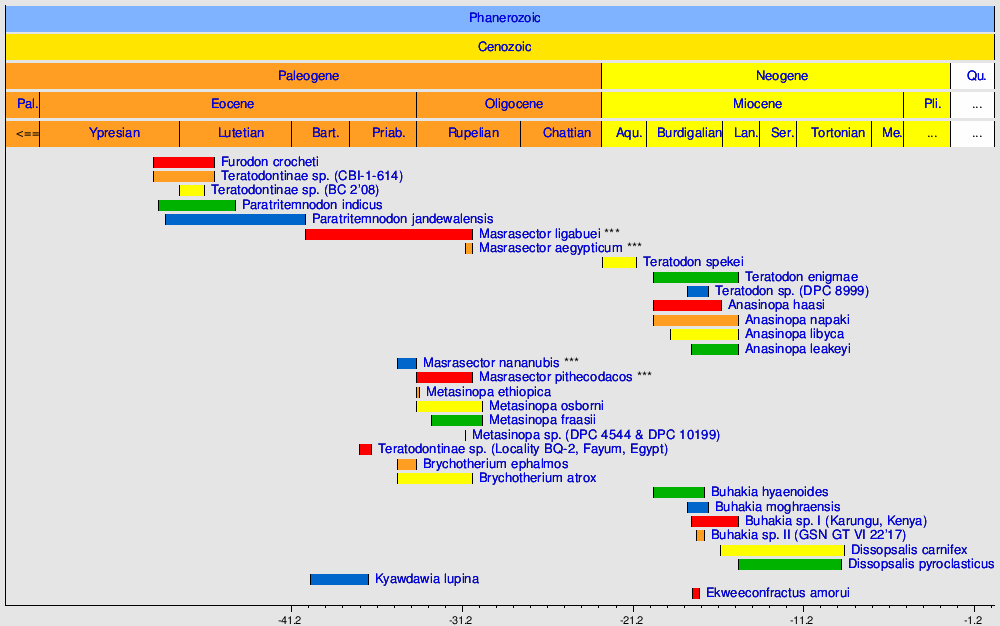Teratodontidae
Teratodontidae (Тератодонтидае — „чудовишни зуби”) је изумрла породица плаценталних сисара из изумрле парафилетске натпородице Hyainailouroidea, која је у периоду од срењег еоцена до касног миоцена настањивала подручје Африке и Азије.[2][3][4][5][6] Ову породицу сисара је чинила само потпородица Teratodontinae, којој припадају племена Dissopsalini и Teratodontini, родови Anasinopa, Brychotherium, Ekweeconfractus, Furodon, Kyawdawia, Metasinopa и Paratritemnodon, парафилетски род Masrasector, као и несврстане врсте Teratodontinae sp. (BC 2’08), Teratodontinae sp. (CBI-1-614) и Teratodontinae sp. (Locality BQ-2, Fayum, Egypt). Стручни назив за чланове ове породице сисара је тератодонтиди.
| Teratodontidae | |
|---|---|

| |
| доња вилица врсте Brychotherium ephalmos | |

| |
| лобања врсте Masrasector nananubis | |
| Научна класификација | |
| Домен: | Eukaryota |
| Царство: | Animalia |
| Тип: | Chordata |
| Класа: | Mammalia |
| Ред: | †Hyaenodonta |
| Натпородица: | †Hyainailouroidea |
| Породица: | †Teratodontidae Savage, 1965[1] |
| Потпородица: | †Teratodontinae Savage, 1965 |
| Типски род | |
| †Teratodon Savage, 1965
| |
| Родови | |
|
| |
Етимологија назива
уреди| Породица: | Поријекло назива од: | Значење назива: |
|---|---|---|
| Teratodontidae |
|
чудовишни зуби |
| Потпородица: | Поријекло назива од: | Значење назива: |
|---|---|---|
| Teratodontinae |
|
чудовишни зуби |
Систематика
уредиКласификација
уредиКласификација породице Teratodontidae:
| Племе: | Род: | Врсте: |
|---|---|---|
| †Anasinopa (Savage, 1965) |
| |
| †Brychotherium (Borths, 2016) |
| |
| †Ekweeconfractus (Flink, 2021) |
| |
| †Furodon (Solé, 2013) |
| |
| †Masrasector (парафилетски род) (Simons & Gingerich, 1974) |
| |
| †Metasinopa (Osborn, 1909) |
| |
| †Paratritemnodon (Ranga Rao, 1973) |
| |
| Incertae sedis |
| |
| (нерангирано): †Kyawdawia група |
†Kyawdawia (Egi, 2005) |
|
| †Dissopsalini (Morales & Pickford, 2017) |
†Buhakia (Morlo, 2007) |
|
| †Dissopsalis (Pilgrim, 1910) |
| |
| †Teratodontini (Savage, 1965) |
†Teratodon (Savage, 1965) |
|
Филогенија
уредиДоље приказан кладограм представља филогенетске везе породице Teratodontidae.[7][8][9][10][6][11]
| †Hyaenodonta |
|
†Lahimia група †Arfia група †Galecyon група †афро-арабијска група | |||||||||||||||||||||||||||||||||||||||||||||||||||||||||||||||||||||||||||||||||||||||||||||||||||||||||||||||||||||||||||||||||||||||||||||||||||||||||||||||||||||||||||||||||||||||||||||||||||||||||||||||||||||||||||||||||||||||||||||||||||||||||||||||||||
| †Teratodontidae |
|
†Kyawdawia група | |||||||||||||||||||||||||||||||||||||||||||||||||||||||||||||||||||||||||||||||||||||||||||||||||||||||||||||||||||||||||||||||||||||||||||||||||||||||||||||||
| ••••••> |
Временска распрострањеност
уредиУнутар парафилетске натпородице Hyainailouroidea
уреди
Унутар породице Teratodontidae
уреди
Види још
уредиРеференце
уреди- ^ R. J. G. Savage (1965.) "Fossil Mammals of Africa: The Miocene Carnivora of East Africa." Bulletin of the British Museum (Natural History) Geology 10(8):241-316
- ^ McKenna, Malcolm C.; Bell, Susan K. (1997). Classification of Mammals Above the Species Level. New York: Columbia University Press. ISBN 978-0-231-11012-9. Приступљено 16. 3. 2015.
- ^ Solé, F.; Lhuillier, J.; Adaci, M.; Bensalah, M.; Mahboubi, M.; Tabuce, R. (2013). „The hyaenodontidans from the Gour Lazib area (?Early Eocene, Algeria): implications concerning the systematics and the origin of the Hyainailourinae and Teratodontinae”. Journal of Systematic Palaeontology. 12 (3): 303—322. doi:10.1080/14772019.2013.795196.
- ^ Matthew R. Borths; Patricia A. Holroyd; Erik R. Seiffert (2016). „Hyainailourine and teratodontine cranial material from the late Eocene of Egypt and the application of parsimony and Bayesian methods to the phylogeny and biogeography of Hyaenodonta (Placentalia, Mammalia)”. PeerJ. 4: e2639. PMC 5111901 . PMID 27867761. doi:10.7717/peerj.2639.
- ^ Matthew R. Borths; Erik R. Seiffert (2017). „Craniodental and humeral morphology of a new species of Masrasector (Teratodontinae, Hyaenodonta, Placentalia) from the late Eocene of Egypt and locomotor diversity in hyaenodonts”. PLOS ONE. 12 (4): e0173527. Bibcode:2017PLoSO..1273527B. PMC 5396875 . PMID 28422967. doi:10.1371/journal.pone.0173527.
- ^ а б Flink, T.; Cote, S. (2021). „The neurocranium of Ekweeconfractus amorui gen. et sp. nov. (Hyaenodonta, Mammalia) and the evolution of the brain in some hyaenodontan carnivores”. Journal of Vertebrate Paleontology. 41 (2): e1927748. doi:10.1080/02724634.2021.1927748.
- ^ Borths, Matthew R.; Stevens, Nancy J. (2017). „Deciduous dentition and dental eruption of Hyainailouroidea (Hyaenodonta, "Creodonta," Placentalia, Mammalia)”. Palaeontologia Electronica. 20 (3): 55A. doi:10.26879/776 .
- ^ Matthew R. Borths; Nancy J. Stevens (2019). „Simbakubwa kutokaafrika, gen. et sp. nov. (Hyainailourinae, Hyaenodonta, 'Creodonta,' Mammalia), a gigantic carnivore from the earliest Miocene of Kenya”. Journal of Vertebrate Paleontology. 39 (1): e1570222. doi:10.1080/02724634.2019.1570222.
- ^ Floréal Solé; Bernard Marandat; Fabrice Lihoreau (2020). „The hyaenodonts (Mammalia) from the French locality of Aumelas (Hérault), with possible new representatives from the late Ypresian”. Geodiversitas. 42 (13): 185—214. doi:10.5252/geodiversitas2020v42a13.
- ^ Solé, F.; Morlo, M.; Schaal, T.; Lehmann, T. (2021). „New hyaenodonts (Mammalia) from the late Ypresian locality of Prémontré (France) support a radiation of the hyaenodonts in Europe already at the end of the early Eocene”. Geobios. 66-67: 119—141. doi:10.1016/j.geobios.2021.02.004.
- ^ Averianov, Alexander; Obraztsova, Ekaterina; Danilov, Igor; Jin, Jian-Hua (2023). „A new hypercarnivorous hyaenodont from the Eocene of South China”. Frontiers in Ecology and Evolution. 11. ISSN 2296-701X. doi:10.3389/fevo.2023.1076819/full.
Литература
уреди- L. Van Valen (1967.) "New Paleocene insectivores and insectivore classification." Bulletin of the American Museum of Natural History 135(5):217-284
- J. Morales, M. Pickford and D. Soria (2007.) "New carnivoran material (Creodonta, Carnivora and Incertae sedis) from the Early Miocene of Napak, Uganda." Paleontological Research 11(1):71-84
- Morales, Jorge; Pickford, M.; Salesa, Manuel J. (2008). „Creodonta and Carnivora from the Early Miocene of the Northern Sperrgebiet, Namibia”. Memoir of the Geological Survey of Namibia. 20: 291—310.
- Margaret E. Lewis and Michael Morlo (2010.) "Creodonta". In: Lars Werdelin and William Joseph Sanders (eds.) "Cenozoic Mammals of Africa". University of California Press, Berkeley, London, New York, pp. 543-560
- Matthew R. Borths; Nancy J. Stevens (2017). „The first hyaenodont from the late Oligocene Nsungwe Formation of Tanzania: Paleoecological insights into the Paleogene-Neogene carnivore transition”. PLOS ONE. 12 (10): e0185301. Bibcode:2017PLoSO..1285301B. PMC 5636082 . PMID 29020030. doi:10.1371/journal.pone.0185301.
- Jorge Morales; Martin Pickford (2017). „New hyaenodonts (Ferae, Mammalia) from the Early Miocene of Napak (Uganda), Koru (Kenya) and Grillental (Namibia)” (PDF). Fossil Imprint. 73 (3–4): 332—359. doi:10.2478/if-2017-0019.
- Floréal Solé; Bastien Mennecart (2019). „A large hyaenodont from the Lutetian of Switzerland expands the body mass range of the European mammalian predators during the Eocene”. Acta Palaeontologica Polonica. 64 (2): 275—290. doi:10.4202/app.00581.2018 .